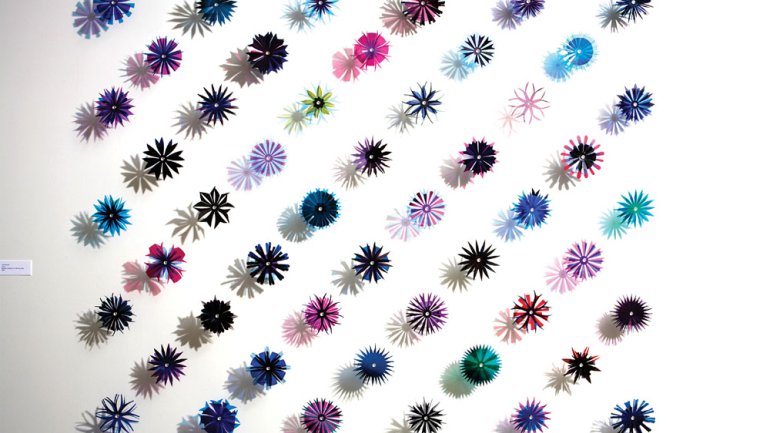E Pluribus X-ray
E Pluribus X-ray
A flock of swallows swoops and swirls as one dynamic mass across an expanse of white wall, continuing around a corner and skirting tall windows on the adjoining wall. We’re used to seeing creatures and plants in nature move synchronously like this – birds, fish, flurries of windblown leaves. Yet each of the dozens of swallow shapes in Julia Barello’s Swoop installation is cut from used MRI film, each one representing an individual human life. It’s a reminder that people, too, often move and act as a swarm.
Barello began experimenting with medical film in the 1990s and started working with it in earnest in 2004, making jewelry, sculpture, and installation art. In 2008, she won best of show in alternative media at the Albuquerque Museum’s Biennial Southwest.
Ghostly and nuanced, her material allows Barello to play with associations and aesthetics as she reflects on the human condition. “Medical film for me became a stand-in for the individual,” notes the 54-year-old artist, who lives in Las Cruces, New Mexico, and teaches art at New Mexico State University there. “The individuals have no name. It’s more the idea of the vast individuality of humankind: We function as groups, but we all also have our individual worlds.”
Barello first incorporated medical film into her art using entire chest X-rays, each mounted on a wall-hung light-box. A sterling silver brooch (which could be detached and worn) was affixed to the illuminated image; the brooch’s delicate branching shape and location against the X-ray echoed the vascular system behind it. Although brooches are usually considered jewelry for women, Barello says her aim was to create entirely gender-free adornment that referenced the pure physicality of the human body.
Using whole X-rays, which display the patient’s name, was no longer an option after medical privacy laws were enacted in 1996. So Barello began creating multiples of iconic shapes from portions of the film whose imagery was most visually intriguing. She initially cut the shapes with a scalpel – an ironic twist, since before the invention of X-ray technology in the late 1800s, the only way to see inside the human body was to cut it open. Today the shapes are created, one at a time, with a laser cutting tool.
In her studio, Barello uses open wall space to design what will become installation works for museums or private collections. Each shape is individually attached to the wall using steel pins up to 10 inches long. Shadows on the wall seemingly double the number of each shape and add further dimension to the overall image, while any stirring of air results in subtle movement. Works such as Bluster and Swoop (both 2007) retain the dark shades of the MRI film, which cannot be dyed, while those using X-rays, especially profusions of flowers, are colored in bright hues.
While the fragments of medical data contained in Barello’s art are barely discernible, the works nonetheless incorporate “pieces of people,” as the artist puts it. Combining these into images from nature is a subtle reminder of humanity’s integral place in the natural world, she says. “These pieces alter the space the viewer moves into. They take us out of ourselves and help us think about something bigger and broader.”
“Interstitial Spaces: Julia Barello & Beverly Penn,” featuring a new collaborative wall installation, is on view at the Houston Center for Contemporary Craft through September 9. Gussie Fauntleroy is a Colorado-based writer who contributes regularly to national and regional publications on art, architecture, and design. She is the author of three books on visual artists.

